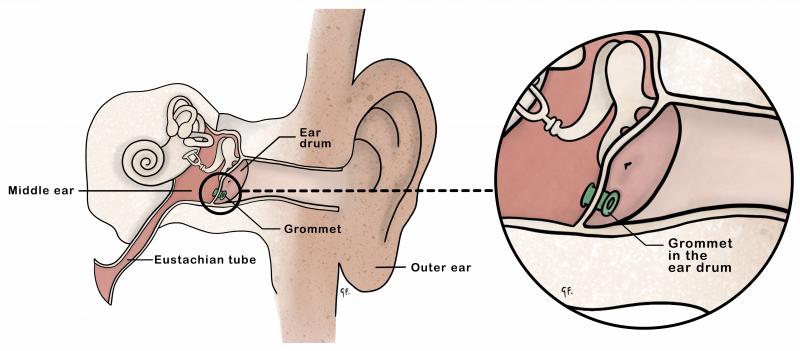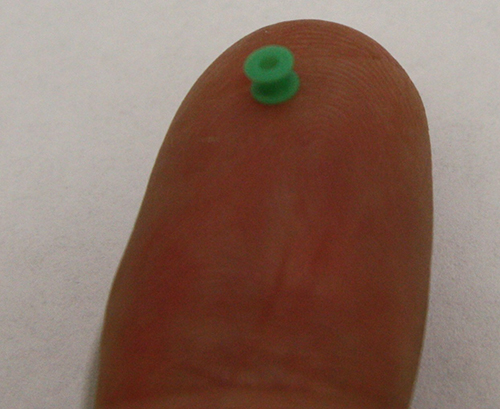Grommets
Grommets
Your child's doctor may recommend grommets if your child has glue ear that won't clear up, or has frequent ear infections.
Key points about grommets
- grommets are tiny plastic tubes inserted into your child's ear drum in a short operation
- your child's doctor may recommend grommets if your child has glue ear that won't clear up, or has frequent ear infections
- grommets allow air into the middle ear (the space behind the eardrum) which reduces the risk of fluid building up there
- if an infection does occur, the pus comes out through the grommet
You might find it helpful to check the information on ear infections and glue ear first.
See KidsHealth's page on ear infections.
See KidsHealth's page on glue ear.
What are grommets?
Grommets are also called tympanostomy or ventilation tubes. They are tiny plastic tubes which are inserted into a small slit in your child's ear drum in a short operation.
A photo of a grommet on an adult finger
The image below shows the inside of an ear with a grommet in the ear drum.

How do grommets work?
Grommets maintain normal middle ear pressure by allowing air into the middle ear, from the outside. This reduces the risk of fluid building up in that space.
Grommets are a temporary measure to help until your child's eustachian tubes mature to work naturally. The eustachian tubes connect the middle ear (the space behind the ear drum) of each ear to the back of the nose.
Most grommets stay in place for about 6 to 18 months and fall out by themselves.
When might my child need grommets?
Your child's doctor may recommend grommets for glue ear that won't clear up or for frequent ear infections. They are more likely to recommend grommets if your child has had:
- glue ear for more than 3 months, depending on the degree of hearing loss
- 6 acute ear infections in one year, especially if the infections have occurred in both ears
- repeat infections through the summer months, when such infections should be less likely to happen
- previous complications because of ear infections
How successful is the grommets operation ?
With grommets in place, any hearing loss caused by fluid in the middle ear will get better.
Parents often report a better quality of life for their children after grommet insertion with better sleeping and overall behaviour.
How are grommets put in?
Your child will need to have an operation to have their grommets put in. They will only need to spend a few hours at the hospital and won't need to stay the night.
- your child will need a brief general anaesthetic
- the surgeon makes a small cut in the ear drum and puts the grommet in
- the surgery usually takes about 10 to 15 minutes
- a specialist ENT (ear, nose and throat) surgeon or registrar will do the operation
How long will my child need to be in hospital after the grommets operation?
When your child has recovered and is wide awake, they are usually allowed to go home. This is often an hour or so after the operation.
What can my child expect after the grommets operation?
There is not usually any pain in the ears after grommet insertion. Although your child may be a little unsettled at first, they are usually back to normal after a few hours. They can usually return to school the following day.
Many parents notice an immediate improvement in their child's hearing. Travelling home with hands over ears because of the 'loud' noises is not uncommon.
Some children will have discharge from their ears after grommets have been inserted. This is not usually painful and is usually treated with ear drops. See your family doctor if this happens. If your child's ear discharge continues, your family doctor may send your child to an ear nurse specialist or ENT specialist.
Does my child need to do anything differently when they have grommets?
Doctors vary in their recommendations about ear protection for your child in water (when swimming, shampooing, showering and bathing). Some children get ear infections and discharge as a result. Ask your surgeon about this at the time of the operation. You can also discuss this with your family doctor or ear nurse.
What if fluid is coming out of my child's ears?
If your child does get an ear infection with grommets in place, pus can flow out through the grommet. See your family doctor or ear nurse if your child has any fluid leaking from their ears. Your family doctor may take a swab. This will show any bacteria which may be causing the discharge.
Your doctor may prescribe some ear drops for your child. Ear drops are more effective than antibiotics by mouth in treating discharging ears. Sometimes, your child might also get help at your local ear clinic from an ear nurse specialist.
What are the possible complications of grommets?
A grommet may occasionally block. If this happens, your child may need ear drops to help clear it.
A small number of children may keep getting fluid leaking from their ears.
There is a small but significant risk of a hole that remains in the eardrum after the grommets come out. If this happens, an operation to repair the hole may be necessary when your child is over 8 years old.
In a small number of children, grommets may not come out by themselves within 3 years. If this is the case, your child may need a further brief general anaesthetic to remove the grommets. The decision to remove working grommets must be weighed up against the possible risk of the return of ear infections and glue ear. You can discuss this with your family doctor or ENT specialist.
Will my child need to have another grommets operation?
Some children continue to have ear problems (glue ear or repeated ear infections) once the grommets come out. They may need grommets again.
Sometimes, your ENT surgeon may also recommend removal of your child's adenoids. There is some evidence that removing the adenoids is helpful in those children who need more than one set of grommets. The adenoids sit at the end of the eustachian tubes at the back of the nose and can contribute to ear infections.
This page last reviewed 30 November 2021.
Do you have any feedback for KidsHealth?
If you have any feedback about the KidsHealth website, or have a suggestion for new content, please get in touch with us.
Email us now
